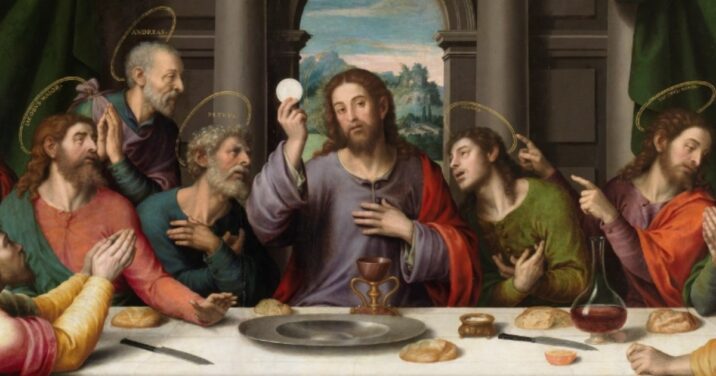The Catholic Church teaches that “there are seven sacraments in the Church: Baptism, Confirmation or Chrismation, Eucharist, Penance, Anointing of the Sick, Holy Orders, and Matrimony” (CCC 1113). But what are these sacraments? Where did they come from? What do they do? Are the seven Catholic sacraments biblical?
In this article, we seek to introduce the seven sacraments of the Catholic Church with primary reference to the Church’s own teaching about the sacraments found in Part II of the Catechism of the Catholic Church (1066–1690). Special attention will be given to the relationship between the sacraments and the Bible.
We will address the following questions in turn:
- What is a sacrament?
- How are the 7 sacraments grouped?
- Did Jesus institute each of the 7 sacraments?
- What is the purpose of each of the 7 sacraments?
- Where can I learn more about the Church’s 7 sacraments?
What is a sacrament?
The use of the term sacrament (Latin sacramentum) in the Church has had a long and varied history.1
Certain figures in the early Church, such as St. Augustine of Hippo, used the term “sacrament” very capaciously to refer to anything in the Church that functioned as a sacred sign. This broad use of the term would include what we now know as the seven sacraments, but also many other sacred realities.
The term sacrament would gradually come to be used in a more restricted way, such that by the time of St. Thomas Aquinas in the thirteenth century, he could give the following definition: “properly speaking a sacrament, as considered by us now, is defined as being the sign of a holy thing so far as it makes men holy” (Summa Theologiae, III q.60 a.2).
Turning to the Catechism of the Catholic Church, we find two paragraphs that complement one another in providing a specific definition of what the seven sacraments are:2
“Seated at the right hand of the Father” and pouring out the Holy Spirit on his Body which is the Church, Christ now acts through the sacraments he instituted to communicate his grace. The sacraments are perceptible signs (words and actions) accessible to our human nature. By the action of Christ and the power of the Holy Spirit they make present efficaciously the grace that they signify. (CCC 1084)
The sacraments are efficacious signs of grace, instituted by Christ and entrusted to the Church, by which divine life is dispensed to us. The visible rites by which the sacraments are celebrated signify and make present the graces proper to each sacrament. They bear fruit in those who receive them with the required dispositions. (CCC 1031)
To summarize:
- The sacraments are outward signs (visible) of God’s grace (invisible) suited to our embodied nature as human beings.
- The sacraments were all instituted by Jesus Christ as the ordinary means by which he would dispense his grace (“divine life”) to the Church.
- The sacraments effect (i.e., make happen) what they signify; namely, they make us holy.
How are the 7 sacraments grouped?
The Catholic Church groups the seven sacraments into three basic categories (see CCC 1211):
- The sacraments of Christian initiation
- Baptism
- Confirmation
- Eucharist
- The sacraments of healing
- Penance
- Anointing of the sick
- The sacraments at the service of communion
- Holy orders
- Matrimony3
St. Thomas Aquinas famously taught that “the spiritual life has a certain conformity with the life of the body” (Summa Theologiae, III 65, 1). That is to say, there is an analogy between our natural life and our supernatural life.
The Churchechoes the Angelic Doctor by teaching that “the seven sacraments touch all the stages and all the important moments of Christian life: they give birth and increase, healing and mission to the Christian’s life of faith. There is thus a certain resemblance between the stages of natural life and the stages of the spiritual life” (CCC 1210). One could rightly say that the seven sacraments “accompany the faithful from the cradle to the grave.”4
1. The sacraments of Christian initiation
These impart “the new life of Christ. … new life as a child of God” (CCC 1420). These three sacraments “lay the foundations of every Christian life” (CCC 1212) and “ground the common vocation of all Christ’s disciples, a vocation to holiness and to the mission of evangelizing the world” (CCC 1533). Returning to the analogy between natural life and supernatural life, the Church teaches that “Baptism … is the beginning of new life; Confirmation … is its strengthening; and the Eucharist … nourishes the disciple with Christ’s Body and Blood for his transformation in Christ” (CCC 1275).
2. The sacraments of healing
These perpetuate the healing ministry of Jesus Christ, “physician of our souls and bodies,” who “willed that his Church continue … his work of healing and salvation, even among her own members” (CCC 1421). This healing is necessary because even after Baptism, Christians are “subject to suffering, illness, and death” (CCC 1420)—the consequences of sin.
3. The sacraments at the service of communion
Holy orders and matrimony are “directed towards the salvation of others; … They confer a particular mission in the Church and serve to build up the People of God” (CCC 1534). Holy orders sets apart those who receive it to “feed the Church by the word and grace of God,” and matrimony strengthens and consecrates Christian spouses “for the duties and dignity of their state” (CCC 1535).
Did Jesus institute all 7 sacraments?
As Catechism 1114 makes clear, quoting the Council of Trent, it is a dogma of faith that all seven sacraments were instituted by Jesus Christ: “we profess that ‘the sacraments of the new law were … all instituted by Jesus Christ our Lord.’” But does this mean that Jesus gave the Church the specific matter and form of all seven sacraments? What does the Church mean when by “instituted”?
Lawrence Feingold summarizes the Church’s teaching with great clarity when he writes,
All seven sacraments by which the Church is formed, gathered, and sanctified were instituted by Christ and promulgated either by Christ in person or by the Apostles, as witnessed in Scripture and Tradition. … The Church’s certainty about Christ’s institution of the sacraments does not come from Scripture alone but also from her living Tradition, in the light of which she interprets her Scriptures in a process of development of doctrine. … Scripture enables us to trace Christ’s institution of most of the sacraments, although not with the same degree of specificity and clarity.5
If we were to take the term “instituted” in an overly narrow way—for instance, we must see Christ giving the explicit rite or manner of celebrating each of the sacraments—then turning to the fourfold Gospel of the New Testament, at most we could say that Jesus instituted baptism, the Eucharist, and possibly penance (depending on one’s reading of John 20).
“The Church has discerned over the centuries that among liturgical celebrations there are seven that are … sacraments instituted by the Lord” (CCC 1117). All seven sacraments were given to the Church by Christ, but analogous to the way that the Church, in the first few centuries, discerned the canon of sacred Scripture, so she similarly discerned and has come to an ever deeper understanding of the seven sacraments.
With that qualification, Feingold does helpfully note that we should not be surprised that Jesus’s institution of baptism and the Eucharist are the most explicit in the Gospels, since these “are the sacraments most central and necessary in the life of the Church.”6
That being said, where can we look in the Bible for evidence of the institution of each of the seven sacraments?7
1. Baptism
Christ, who would baptize “with the Holy Spirit and fire” (Matt 3:11), sanctified the waters when he was baptized by John in the Jordan. Jesus declares the necessity of Christian baptism to Nicodemus (John 3:3–5). Jesus explicitly commands his disciples to make disciples of all nations by baptizing them with the Trinitarian formula (Matt 28:19–20).
2. Confirmation
Jesus promised to send his own Spirit upon his disciples (e.g. John 14–16; Acts 1:4–5, 8), which was fulfilled on Pentecost (Acts 2). This gift of the Holy Spirit is imparted by the act of laying on of hands by the apostles Peter and John (Acts 8:14–17) and later Paul (Acts 19:6).
3. Eucharist
Jesus formally instituted the Eucharist at the Last Supper, as attested by three of the Evangelists and St. Paul (Matt 26:20–29; Mark 14:17–25; Luke 22:14–20; 1 Cor 11:23–25). The fourth Gospel contains the Bread of Life discourse (John 6) in which Jesus speaks of his own (resurrected) flesh and blood as “true food” and “true drink” (John 6:55).
4. Penance (Reconciliation)
On Easter, Jesus gives to his disciples the power to forgive and retain sins (John 20:21–23). This power may also be attested in James 5:16.
5. Anointing of the sick
Jesus sends out the Twelve during his public ministry and “they anointed with oil many who were sick and healed them” (Mark 6:13). The final chapter of the letter of James explicitly promulgates the sacraments (Jas 5:14–15).
6. Holy Orders
This sacrament is intimately tied to Jesus’s command at the Last Supper to “Do this in remembrance of me” (Luke 22:19); namely, the offering of the sacrifice of the New Covenant which implies a priesthood who would offer the sacrifice. The New Testament attests to three degrees of holy orders (bishops, priests/presbyters, deacons) in an analogous manner to the threefold division of the Levitical priesthood (Aaron/high priest, sons of Aaron, Levites)
7. Matrimony
Jesus attests that marriage is part of the created order (Matt 19:4–6, 8). He restores it to its fullness and instituted it sacramentally, “raising it to the dignity of a sacrament” when he espouses the Church, his bride, on the Cross (see Eph 5:31–32) by giving his life for her.
What is the purpose of each of the 7 sacraments?
One of the most helpful ways of approaching the sacraments is to ask about their purpose. What does this sacrament do? Why did Jesus give this sacrament to his Church? For whom is the grace of this sacrament intended? To answer questions such as these, one does well to begin by reading the Catechism’s discussion of the “Grace” or “Effects” of each sacrament.8
. In brief, we can identify the purpose of each of the seven sacraments as follows:
1. Baptism
Baptism is the most necessary of sacraments. Baptism unites us to Christ and gives the initial gift of sanctifying grace, thereby effecting the forgiveness of sins—original sin and all personal sins—as well as giving new birth in the Holy Spirit as sons and daughters of God and members of the body of Christ, the Church.
The grace of baptism is necessary for salvation (see CCC 1257–61), and so all who have not yet been baptized are able to be baptized, as baptism is given only once—”one baptism for the forgiveness of sins.”9
2. Confirmation
This sacrament effects a special outpouring of the Holy Spirit, signified by the anointing with oil and laying on of hands, that strengthens the baptized to bear witness to Jesus Christ, even in the face of suffering and persecution. Confirmation, like baptism, imprints an indelible spiritual mark (the sacramental character), and so is only given once.
3. The Eucharist
The Eucharist is received in Holy Communion. It nourishes the faithful with the gift of Christ’s own body and blood. Worthy reception of the Eucharist increases our union with Christ and thereby also reinforces the unity of the mystical body of Christ, the Church. Thus, one could say that the Eucharist is a privileged sacramental means of living out the twofold commandment of love.
All the faithful are obliged to receive the Eucharist at least once a year, preferably in the Easter season, but as the heart of the Christian life, the Church encourages frequent, even daily reception of the Eucharist.
4. Penance (Reconciliation)
This sacrament restores sanctifying grace and charity (first received through baptism) to any Catholic who has lost it through mortal sin. This sacrament thereby reconciles the disciple who has fallen to God and the Church.
Though all the faithful are required to go to confession at least once a year, regular reception of this sacrament (e.g., monthly) is encouraged for all those striving to grow in the spiritual life.
5. Anointing of the sick
This sacrament is given to any who are seriously ill or facing death in order to unite the the sick person to Christ crucified and strengthen him to face illness and death with faith and courage.
6. Holy Orders
This sacrament is reserved for baptized men who are called to serve the Church as special instruments of Christ. Holy Orders, like baptism and confirmation, endows a sacramental character, which configure the deacon, priest, or bishop more fully to Christ as “Priest, Teacher, and Pastor” (CCC 1585). Each degree of Holy Orders confers particular graces ordered to the building up of the flock of Christ the Good Shepherd.
7. Matrimony
This sacrament confers on a baptized man and woman the grace to love one another as Christ has loves his Bride, the Church. It strengthens the unity of the spouses amidst the many challenges of married and family life, especially in their roles as father and mother to their children.
Where can I learn more about the Church’s 7 sacraments?
Resources for studying the seven sacraments of the Catholic Church abound. The following are a few recommended resources published within the past decade that are well suited for those wanting to dig deeper and learn more about these “masterworks of God” (CCC 1116).
Touched by Christ: The Sacramental Economy, by Lawrence Feingold
As evidenced by this article, Lawrence Feingold’s 700-page treatment of the sacraments is an invaluable resource for understanding the Church’s sacramental theology in light of its historical development. Feingold is a very lucid and compelling writer, and he has a special gift for making accessible the teachings of the Church.
A Catholic Biblical Theology of the Sacraments (Baker Academic)
The titles in this series turn to the Bible in light of the Church’s faith; that is, according to the publisher’s website, the teaching of the Church serves as the “starting point of faith for theological reflection. The series does not aim primarily to demonstrate the truth of Catholic sacramental doctrine but to understand it more deeply … [in order] to foster a deeper appreciation of God’s gifts and call in the sacraments through a renewed encounter with his Word in Scripture.”
This series is warmly recommended for those wishing to dive deep into the biblical foundation of the Church’s sacraments. Three volumes have been published to date:
- The Bible and Baptism: The Fountain of Salvation, by Isaac Augustine Morales, OP
- The Bible and the Priesthood: Priestly Participation in the One Sacrifice for Sins, by Anthony Giambrone, OP
- The Bible and Reconciliation: Confessions, Repentance, and Restoration, by James B. Prothro
Speaking the Love of God: An Introduction to the Sacraments, by Jacob W. Wood
After a brief introduction to the sacramental nature of the Church as a whole, Wood treats each of the seven sacraments in turn with respect to:
- Key biblical texts and Church teaching that illuminate its theology
- Its celebration
- Its effects
- A brief but very helpful treatment on appropriating and living out the sacrament.
Each chapter gives suggested readings from the Old Testament, New Testament, Catechism, and Code of Canon Law.
- For an in-depth discussion of the historical development of the Church’s definition of “sacrament,” see Lawrence Feingold, Touched by Christ: The Sacramental Economy (Steubenville, OH: Emmaus Academic, 2021), 37–68.
- Here the Catechismis completely in line with the definition of sacrament given by the Council of Trent. The Catechism of the Council of Trent defined sacraments as “something perceptible to the senses which, by virtue of its divine institution, has the power both to signify and to effect holiness.” The Roman Catechism, trans. Robert I. Bradley and Eugene Kevane (Boston: St. Paul Editions, 1985), as quoted in Feingold, Touched by Christ, 62–63.
- It is worth noting that in CCC 1211, these two sacraments are described more fully as “the sacraments at the service of communion and the mission of the faithful.”
- David W. Fagerberg, “Liturgy, Signs, and Sacraments,” in The Oxford Handbook of Sacramental Theology, eds. Hans Boersma and Matthew Levering (Oxford: Oxford University Press, 2015), 463.
- Feingold, Touched by Christ, 99–100.
- Feingold, Touched by Christ, 100.
- Here I am indebted to Feingold’s treatment of the subject in Touched by Christ, 100–106.
- “The Graces of Baptism” (CCC 1262–74); “The Effects of Confirmation”; “The Fruits of Holy Communion” (CCC 1391–1401); “The Effects of [Penance]” (CCC 1468–70); “The Effects of the Celebration of [Anointing of the Sick]” (CCC 1520–23); “The Effects of the Sacrament of Holy Orders” (CCC 1581–89); “The Effects of the Sacrament of Matrimony” (CCC 1638–42). See also the extended treatment in Feingold, Touched by Christ, 359–80.
- For a much more in-depth and nuanced discussion of the necessity of the sacraments, including Baptism, see Feingold, Touched by Christ, 552–60.





